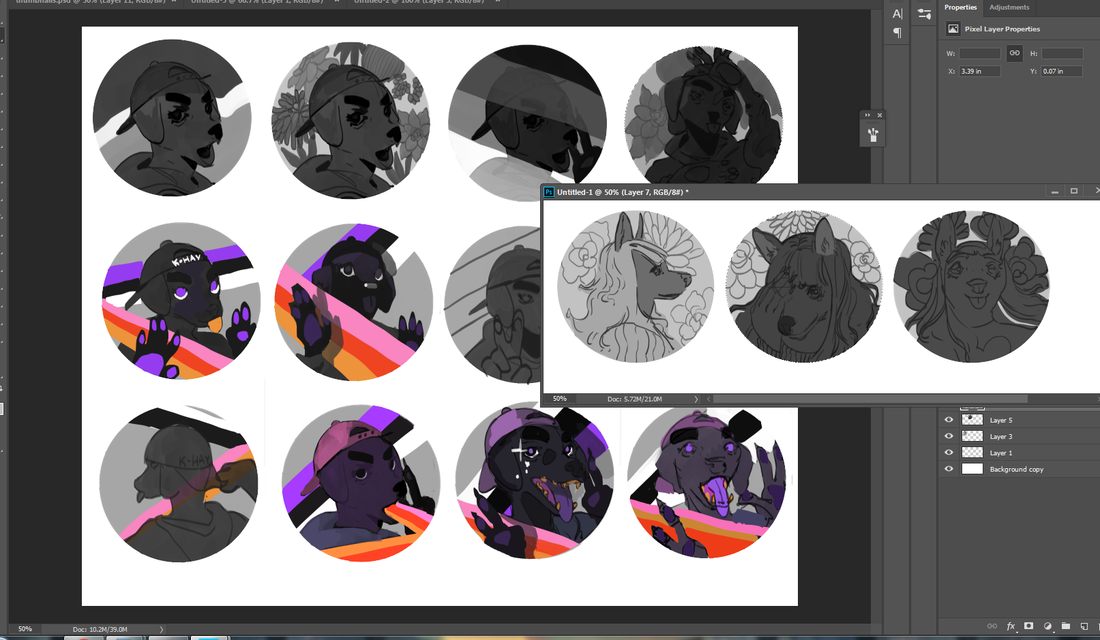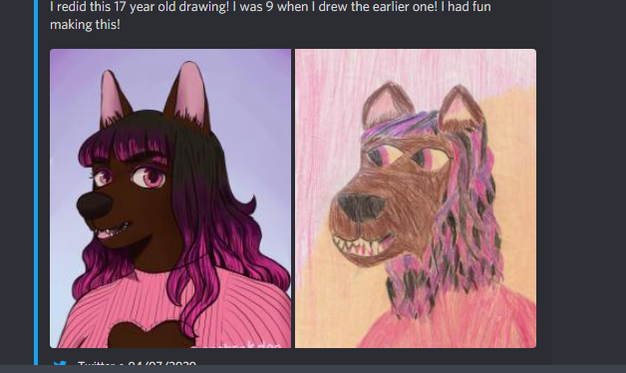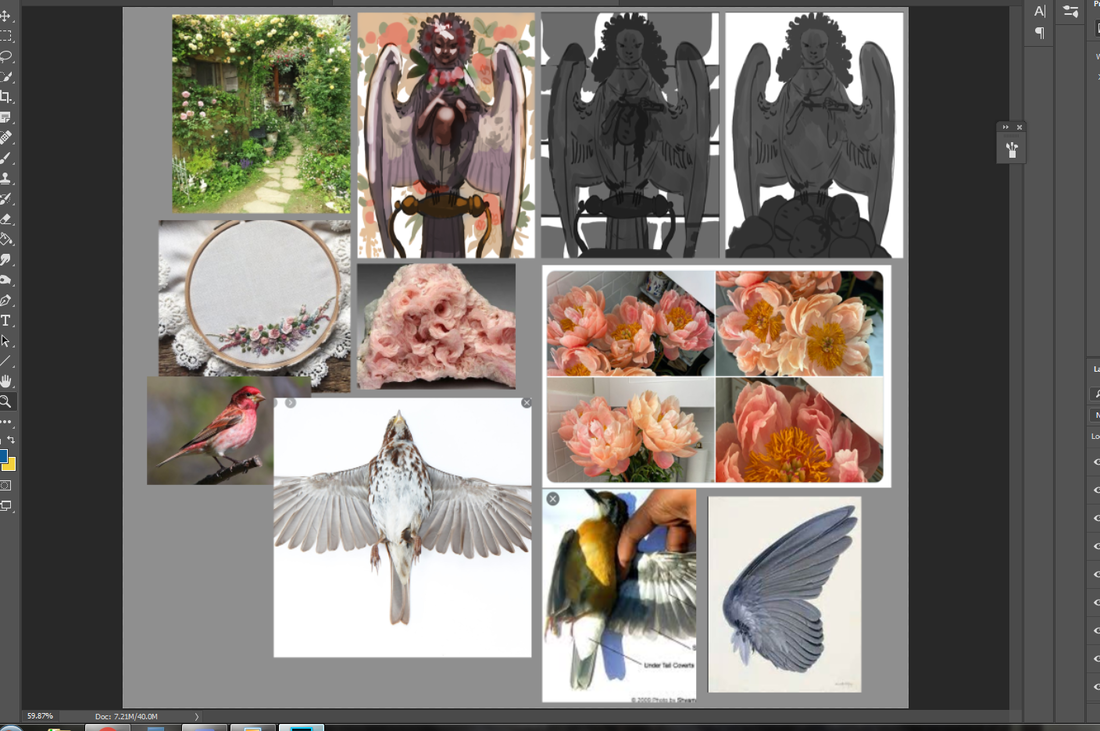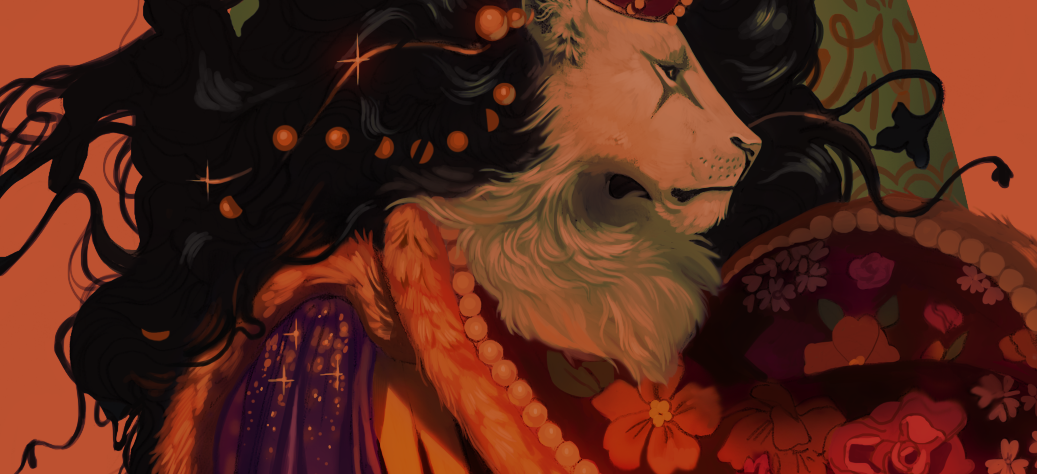|
There's always a simpler way to do things. I firmly believe in working smarter, not harder. We turn to custom brushes to help us get down redundant elements like foliage or scales with half the effort. We buy or create stencils so we can get down more accurate shapes without burning out our already precarious energy. Following this logic, this second acrylic painting went by a little quicker than the first due to me already having some paints mixed up from the last one, as well as the thumbnails being done in advance. The composition is similar to the first painting, to boot, and it all whittled an hour or two out of the process. I like it. This is an aspect of the creation process I'm keeping in mind for future work. What are ways I can snip out a little of the grind? How can I reuse past thumbnails or similar ideas for new projects? I've got more .psd files than I'd like to admit stuffed to the brim with spontaneous painting concepts, which I...really should organize into their own folder. That's so much fertilizer for new work. If you've got some old, unfinished art lying around, consider pulling them back out again and giving them a review. You could just have a hidden gem languishing away unseen. If you haven't read my first post for the first acrylic painting, check it out here. This character belongs to Khailed, a fellow illustrator who is currently open for icon and portrait commissions. Without further ado! To the left are a few of the thumbnails I did while working on the first acrylic painting. I was already solidly in the groove and felt like trying my hand at their original character as I let the other thumbs simmer. I adored their character's rosy ombre hair and little heart sweater (already similar to my own fashion sense).
If you can't already tell, they have a knack for simple-and-striking designs. I've noticed how they tend to embody two or three poppy colors and a dominant fashion focal point, like a hat or a top. Really, they hearken to some of the best platformer characters of the 90's.
0 Comments
I haven't traditionally painted in almost a year. You heard that right. Despite what you may hear in snooty art circles, it's not necessary to draw or paint every day to keep a skill alive. In fact, taking a break can be just as beneficial as hard practice. As it stands, 2020 burnt me out pretty hard. Not only was I running out of steam juggling several gigs throughout a stressful year, I pulled a muscle in my neck and upper shoulder in the middle of a hefty project and found myself bedridden for a week. I was popping Tylenol every six hours, struggling to walk further than my kitchen and, at one point, found myself dissolving into tears of frustration. That injury also happened right when my period started! Yeah. That was a fun week. It's worth noting that digital painting and traditional painting are similar enough as it is, so I technically never fell out of practice. Still, it was refreshing to revisit my old supplies and dip into a well-worn skill. A friend of mine sent me a wonderful custom postcard not too long afterwards, which made my whole month. They're a fantastic illustrator and designer looking to try their hand at packaging design soon (and you can find their portfolio here). What better way to say thank you than with some art of my own?
You just have to speak things into existence. I was contacted by Zero Issue Beer not too long ago -- a Canadian craft brewery -- and was asked if I was interested in doing an illustration for their new seasonal beer line-up. What a coincidence 2020 was the year I wanted to get into packaging design and illustration, particularly for beverages! Even better, the proceeds are going to Sankofa Arts & Music Foundation for black Canadian youth. As you can likely imagine, I was sold twenty times over. I have a short interview that will be appearing on their site here. For now? I'm going to share the creative process behind this piece, from the rough beginning stages to the inspiration behind it all. I'll share some tips I've learned about packaging design, too, for any of you who want to branch out your portfolio. Spoiler: there are harpies.
Been a while since I've done one of these! Indulgent art has always held a high priority for me. Why bother painting or drawing things I'm not invested in? Not to mention I need to show what I want to get hired for, so...kill two birds with one stone. This piece, however, was peak indulgence. Like, a dollop of whipped cream on top of whipped cream indulgence. You have a harpy. You have flowers. You have a ton of colors. Hell, there are even the mildest of vaporwave vibes (pink + blue surrealism) that snuck in without me realizing. Expect to see more of that. This year has been an absolute trainwreck and it's barely halfway over. Soaking in the subjects and styles I love to the nth degree is as self-care as it gets. As a side-note, I'm going to be keeping these progress posts a little brief from now on so I don't repeat myself. I mean, you know I love color. The part where I start phasing out the sketch and start rendering is orgasmic. Yadda yadda. I'll focus more on the unique challenges of each piece and what, exactly, was going on in my mind when making it. It's time to get indulgent.
Being a curmudgeonly, introverted remote freelancer isn't exactly...prime wellness material. When you can reach for a bag of chips and nap whenever you want, an ideal weight easily falls to the wayside. I'll start this off with the usual disclaimer: we all have different reasons for wanting to diet and exercise. Some do so because they want to fit into their old skinny jeans again (I see you). Others want to try and circumvent the institutionalized bias toward fat bodies in medicine and traditional workspaces. My own reasons are just as varied. Exercise is a major sleep aid for me, since I struggle with insomnia: I sleep deeply, but getting to sleep is a problem. It's also a reliable painkiller for my bad shoulder and improves my mood. ...I also want to fit into some of my old clothes. Yeah, this cup size is doing me few favors. It's all gotten me to thinking on perspectives concerning exercising and dieting: how they often feel like a punishment or a chore than enrichment. The coronavirus pandemic has exacerbated the home habits of many, making those already often at home feel even more cooped up than usual. How can you start a new regimen when just keeping your head on straight in all this chaos feels impossible?
Which artists deserve credit and which one's don't? Trick question! All of them do. So, I came across a job posting for an illustration gig the other day that had my higher brain functions in a bit of a fit. I won't go into the specifics, but it's one that interested me on several levels. I ended up not just skipping the application, but walked away with inspiration for one very annoyed, very specific blog post. I'll start this off with a nice, easy fact: artists deserve credit for their work. At the risk of sounding blase, there would be no work without the artist. This seems like a simple nugget of wisdom, yet, unfortunately, we live on the planet Earth. Here we have Twitter users reposting other people's work without credit (or giving credit in the second, less-viewed comment), shady online sellers making profit off of stolen designs and potential clients haggling down professionals. The job application I came across was more insidious, appearing perfectly professional on the surface with its highly specific rundown of the job and all that it would entail. That is, until it came to the pesky subject of due credit: this would be a work-for-hire position that would see all copyright going to the owner. As a working professional with over five years of experience, this is nothing new to me. ...Until I got to the following stipulation: the artist may get credit...as long as they are high-profile. Ha ha. Yikes.
Self-care is a fact of life. No ifs, ands or buts about it. This is your body: it's all you truly have. Artists, from illustration undergraduates to experienced animators, are taught to devalue themselves from the word 'go'. The starving artist stereotype is imposed with impunity by a Western society that simultaneously craves art and dismisses artists, manifesting as art theft (with Aaron Carter a very recent example) or accusations of bloated egos. For any of you reading this with commission work under your belt, I'm sure you have at least one story of a potential client that tried to haggle your prices down (if they didn't just ghost). All of these minor and major blows have a way of leaving us lacking in the self-care field. Why should we spend so much time taking care of ourselves when our work is 'easy' and 'unimportant'? Part of self-care is changing your mindset around what you have to offer the world. Offer yourself. Mind over matter: you won't stick to a stretching or jogging regimen unless you acknowledge how much you need it. Denying myself reasonable breaks and taking on very low-paying jobs (among other things) had me experiencing burnout in the past. Badly. It's an all-encompassing exhaustion that starts from your toes and trickles up to the roots of your hair. You can hardly string two words together. You can barely think beyond your next meal (if you're not too depressed to eat, that is). You sleep too much. You zone out too much. The mere thought of work is enough to have you laying back down. Here I'm going to explain my daily self-care habits and how they pertain to my work: the unglamorous and wholly necessary routines of keeping my health sound and burnout as far away as humanely possible. There will be links to guides and videos so you can start experimenting with your own unique variation. It takes an average of two months to cement a new habit: the sooner you build one, the sooner it can start working to your benefit. This list isn't here to clear your skin or cure your depression overnight. It's to make your exhausting and painful existence slightly less so.
No Freelancer Is An Island: Five Free Or Low-Cost Freelance Resources That Have Helped Me Greatly1/21/2020 Being a freelancer is rough. Thing is? It doesn't have to be. Take it from someone whose instinct is to try and do everything on her own: don't. Not only will you run the risk of burning yourself out prematurely, you can set yourself up for failure by missing important legal details or drastically underpricing. There are free and affordable resources out there that can take the sting out of the freelancing process. Pricing, marketing, state law, copyright, portfolio direction, you name it. You can't create a piece of art without tools, right? The same goes for running a successful business. Below are five resources I use on a weekly -- sometimes daily -- basis, useful for both experienced freelancers and budding professionals starting to dip their toes into the working world. Without further ado:
Sometimes you need to start over fresh. There's no shame in it. Why waste effort picking away at something you could just re-do in half the time? Other times, though, you'll need to bite the bullet and push through. Knowing which one of these to commit to is part of being a productive artist. I've talked about it before and I'll repeat until I'm blue in the face. It's a gamechanger. Now that that's out of the way...let me start this by saying I wanted to drop this piece like a cheap vase. Even worse? This was one of my favorite sketches in my sketch batch. Talk about artistic whiplash. It didn't help I was winging the color scheme and many of the supporting details (a habit I've developed since color theory is one of my strongest skills). I had a vague idea I wanted blue and gold, that I wanted everything fancy and dream-like...and that was about it. For once, my guesswork backfired and made me fudge around more than normal. This doesn't happen often -- I've winged crazier pieces than this -- but it cost me several hours that could've been saved if I fleshed out the draft stages better. This was a good reminder of how badly a piece can backfire if you don't have the basics down. I thought of throwing my hands up in the air and outright moving on to another sketch, but something about this one told me to keep going. 'Make it work' is a phrase made famous from Project Runway and one I've adopted. It's a saying that tells you to work with your mistakes and find a way out of the hedgemaze you've built for yourself. I might just have to do a post on all my personal quotes one of these days. (If you're curious about other pieces I've done, check out my recent post on the progress of 'Yasar'.)
I have so many characters. Jesus Christ. It's to the point that even doing art of other characters I don't paint very often feels excessive. Like I'm choosing a favorite child. As it stands, I've only drawn Yasar a few times, despite the fact he's a prominent supporting character in a big (and very old) story of mine. I'd go into greater detail about his personality and history, but I'm viciously protective of my intellectual property. Maybe someday when I actually commit this story to a game or a book. I like to separate character art into three categories: simple, complex and illustrative. The first is exactly what it says on the tin, with no background or any supporting elements whatsoever. The middle adds a little more, such as an item or animal. The latter is an illustration in all but name, with the focus still heavily on the character themselves. I take a lot of inspiration from fashion magazines for that last one, since they tend to showcase models in all sorts of environments that play second-fiddle to the subject. This character art is somewhere between a simple and complex, as the giant gilded egg fills out the space without any additional interaction. Funny enough, even after extensive thumbnailing (see below), I still didn't have any idea what I was going to put behind him. Just...something. Something to round out that space! Throwing in a big fancy egg while painting ended up giving me an idea for one of his powers, since he's an illusionist that depends on sleight-of-hand and a jack-of-all-trades approach. ...Don't do what I did, though. Figure everything out in the draft stage. It'll save you so much more trouble.
|
AuthorHere I post WIPs, sketches, speedpaints, thumbnails and anything else thrown into the veritable stew of artistic process. Archives
January 2021
Categories
All
|
ServicesBook Covers
Illustration Character Art Portraits Packaging Art Concept Art |
AboutCommercial illustrator and designer currently available for short-term and long-term freelance work.
|
© COPYRIGHT 2015. ALL RIGHTS RESERVED.
|




 RSS Feed
RSS Feed